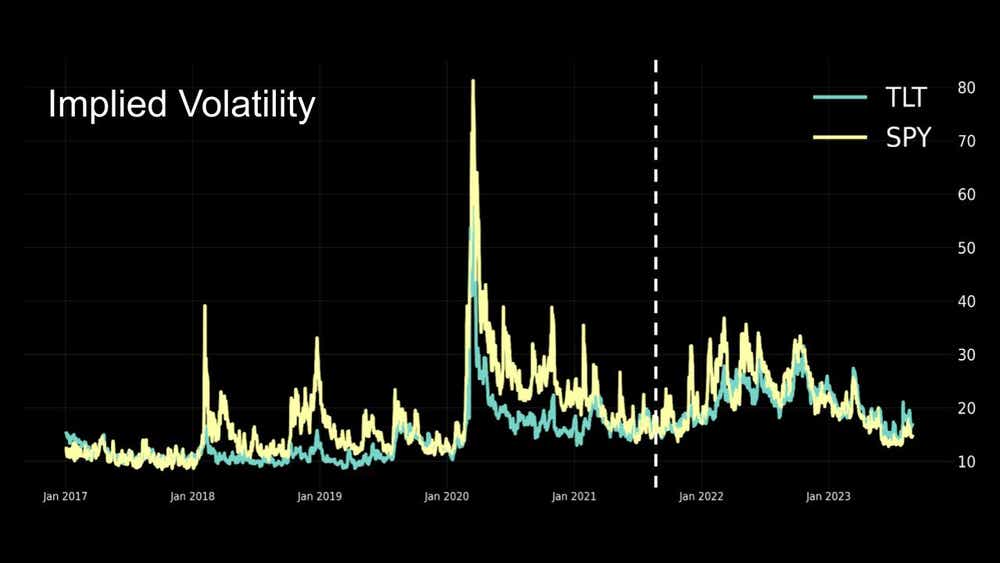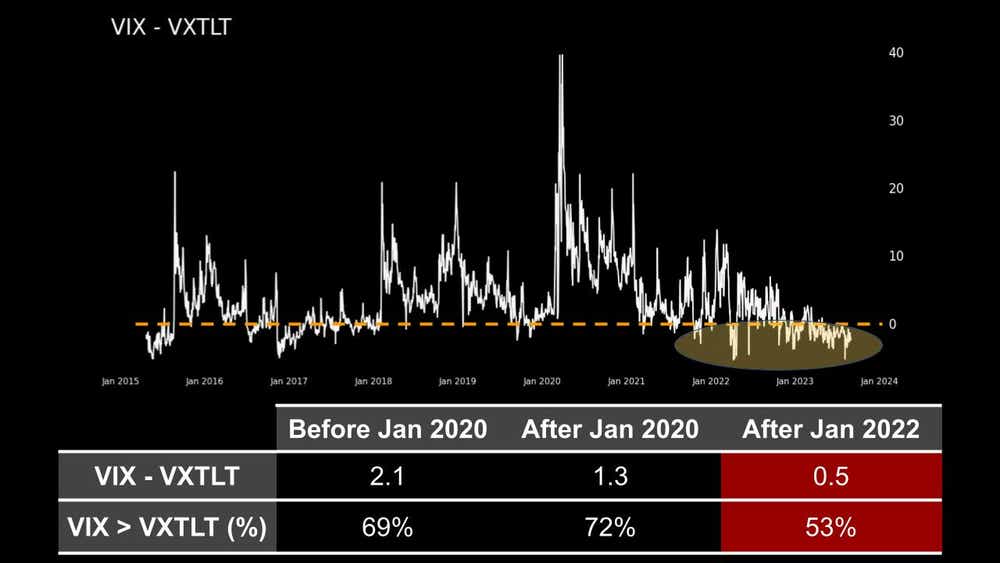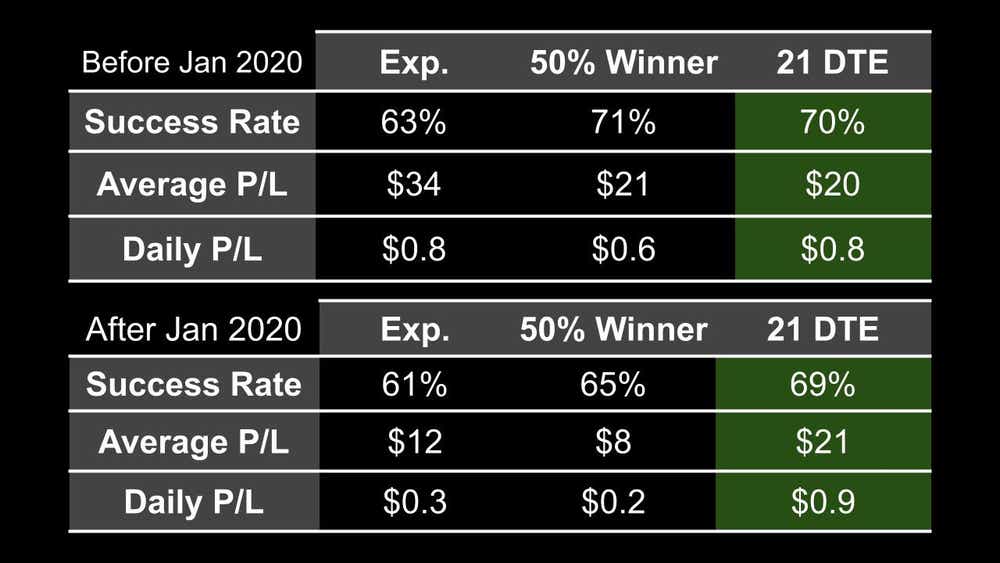Selling Premium in TLT

Selling Premium in TLT
By:Kai Zeng
Establishing positions when implied volatility is higher can boost overall performance
TLT, a 20+ year Treasury bond ETF, was traditionally less favored by option sellers due to its lower options premium, reflected in its implied volatility. Conversely, the most traded ETF, SPY, known as the fear index “VIX,” has a higher implied volatility, despite being relatively low compared to other equities and ETFs like Apple (AAPL) or Tesla (TSLA).
However, the upheaval of the pandemic and subsequent economic adjustments altered this trend. The Federal Reserve's swift decision to cap inflation by raising interest rates gave TLT’s implied volatility an unexpected surge.

Before January 2020, the spread between VIX (SPY’s IV) and VXTLT (TLT’s IV) averaged at 2.1%. This discrepancy began to diminish with the onset of the pandemic. By 2022, when the Fed began increasing interest rates, it had narrowed to half a point. Furthermore, the percentage of days when VIX exceeded VXTLT approached 50%, indicating that nearly half of the time, VXTLT was higher than VIX.

Now, the question arises: Is selling premium in TLT profitable now when the IV is higher? Can we anticipate better performance than in a lower IV market? To investigate this, we conducted a study, analyzing 45 DTE 16 delta SPY and TLT Strangles. These positions were managed in three ways: held until expiration, managed at a 50%-win rate, and exited at 21 days to expiration (DTE).
Before 2020, the performances were unimpressive due to the lower premium. While the success rates were commendable, the low-IV markets did not yield substantial profits. However, post-2020 results improved with higher IV, with management at 21 DTE proving to be the most effective strategy.

Compared to other indices like SPY, the profit from the 16 delta TLT strangle was lower. To address this, we conducted another analysis, increasing the risk and the premium by opting for higher deltas like 40. As expected, the success rates were lower for higher delta positions, regardless of management strategy.
However, with effective management, specifically 21 DTE, the success rate was not much lower than that of 16 delta strangles. This is impressive considering the breakeven points are significantly tighter when using 40 delta options. The overall performance remained satisfactory with significantly better P/L, especially when selling the same strategy in a higher IV market post-2020.

In light of these findings, it's clear that traders should not overlook selling premium in TLT, despite its lower implied volatility. Entering positions when the IV is higher can boost overall performance. Regardless of the level of IV or the chosen strategy, managing at 21 DTE can help maintain the success rate and increase overall profits.
In conclusion, the trading landscape is dynamic and constantly evolving. Traders must adapt their strategies to these shifts. Despite its historical underperformance, TLT has shown potential for profitability. By adjusting strategies and managing risk effectively, traders can harness these changes to their advantage.
Kai Zeng, director of the research team and head of Chinese content at tastylive, has 20 years of experience in markets and derivatives trading. He cohosts several live shows, including From Theory to Practice and Building Blocks. @kai_zeng1
For live daily programming, market news and commentary, visit tastylive or the YouTube channels tastylive (for options traders), and tastyliveTrending for stocks, futures, forex & macro.
Trade with a better broker, open a tastytrade account today. tastylive, Inc. and tastytrade, Inc. are separate but affiliated companies.
Options involve risk and are not suitable for all investors. Please read Characteristics and Risks of Standardized Options before deciding to invest in options.
tastylive content is created, produced, and provided solely by tastylive, Inc. (“tastylive”) and is for informational and educational purposes only. It is not, nor is it intended to be, trading or investment advice or a recommendation that any security, futures contract, digital asset, other product, transaction, or investment strategy is suitable for any person. Trading securities, futures products, and digital assets involve risk and may result in a loss greater than the original amount invested. tastylive, through its content, financial programming or otherwise, does not provide investment or financial advice or make investment recommendations. Investment information provided may not be appropriate for all investors and is provided without respect to individual investor financial sophistication, financial situation, investing time horizon or risk tolerance. tastylive is not in the business of transacting securities trades, nor does it direct client commodity accounts or give commodity trading advice tailored to any particular client’s situation or investment objectives. Supporting documentation for any claims (including claims made on behalf of options programs), comparisons, statistics, or other technical data, if applicable, will be supplied upon request. tastylive is not a licensed financial adviser, registered investment adviser, or a registered broker-dealer. Options, futures, and futures options are not suitable for all investors. Prior to trading securities, options, futures, or futures options, please read the applicable risk disclosures, including, but not limited to, the Characteristics and Risks of Standardized Options Disclosure and the Futures and Exchange-Traded Options Risk Disclosure found on tastytrade.com/disclosures.
tastytrade, Inc. ("tastytrade”) is a registered broker-dealer and member of FINRA, NFA, and SIPC. tastytrade was previously known as tastyworks, Inc. (“tastyworks”). tastytrade offers self-directed brokerage accounts to its customers. tastytrade does not give financial or trading advice, nor does it make investment recommendations. You alone are responsible for making your investment and trading decisions and for evaluating the merits and risks associated with the use of tastytrade’s systems, services or products. tastytrade is a wholly-owned subsidiary of tastylive, Inc.
tastytrade has entered into a Marketing Agreement with tastylive (“Marketing Agent”) whereby tastytrade pays compensation to Marketing Agent to recommend tastytrade’s brokerage services. The existence of this Marketing Agreement should not be deemed as an endorsement or recommendation of Marketing Agent by tastytrade. tastytrade and Marketing Agent are separate entities with their own products and services. tastylive is the parent company of tastytrade.
tastyfx, LLC (“tastyfx”) is a Commodity Futures Trading Commission (“CFTC”) registered Retail Foreign Exchange Dealer (RFED) and Introducing Broker (IB) and Forex Dealer Member (FDM) of the National Futures Association (“NFA”) (NFA ID 0509630). Leveraged trading in foreign currency or off-exchange products on margin carries significant risk and may not be suitable for all investors. We advise you to carefully consider whether trading is appropriate for you based on your personal circumstances as you may lose more than you invest.
tastycrypto is provided solely by tasty Software Solutions, LLC. tasty Software Solutions, LLC is a separate but affiliate company of tastylive, Inc. Neither tastylive nor any of its affiliates are responsible for the products or services provided by tasty Software Solutions, LLC. Cryptocurrency trading is not suitable for all investors due to the number of risks involved. The value of any cryptocurrency, including digital assets pegged to fiat currency, commodities, or any other asset, may go to zero.
© copyright 2013 - 2025 tastylive, Inc. All Rights Reserved. Applicable portions of the Terms of Use on tastylive.com apply. Reproduction, adaptation, distribution, public display, exhibition for profit, or storage in any electronic storage media in whole or in part is prohibited under penalty of law, provided that you may download tastylive’s podcasts as necessary to view for personal use. tastylive was previously known as tastytrade, Inc. tastylive is a trademark/servicemark owned by tastylive, Inc.